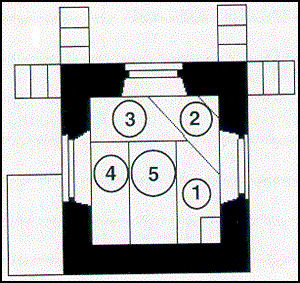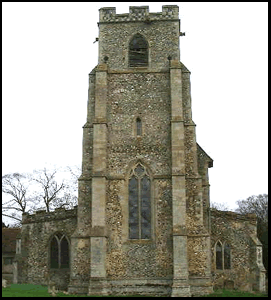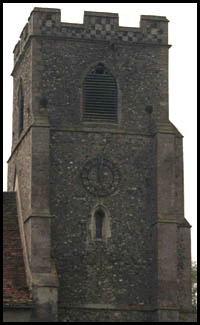  |
 |
 |
 |
 |
| Mon 16 Jun 2025 |

The History Of All Saints' WickhambrookBells - Tower - OrganBellsAlthough in antiquity bells, or more correctly gongs or cymbals, were in use in Babylonia, Egypt as well as in Greek and Roman times the first mention of bells in a Christian context is by the writer Gregory of Tours (c. 585) who frequently speaks of bells being struck or shaken. Mention is also made of a cord being used for this purpose. It appears bells were rung before church services and that they roused monks from their beds. In Celtic lands an extraordinary importance was attached to bells and indeed a very large number of these ancient bells, more than sixty in all (the majority being Irish) are still in existence. Many of them are reputed to have belonged to Irish saints. The most famous is that of St. Patrick, the clog-an-edachta, or "bell-off-the-will" now preserved in the Museum of the Royal Irish Academy, Dublin and dated 552. The great development in the use of bells may be identified with the eighth century. It was then that bells began to be regarded as an essential part of the equipment of every church, and the practice of blessing them by a special form of consecration became commonplace. It was in the eighth century that church towers began to be built for the express purpose of hanging bells suggesting that bell size was also increasing. By the ninth century nearly every parish church was expected to have a bell. The missionary's hand-bell, which was used to gathered his congregation together in the open air, was a thing directly associated with him and his work. Indeed, the practice blossomed so that no religious service could take place without some preliminary bell ringing. Although evidence of the use of signa and companae in monasteries before the Irish became missionaries is suggested, there is no evidence to show that these were bells rather than gongs. Concomitantly in Ireland the shape of the bell was taking place, from the small cow-bell of riveted iron to a cast bronze instrument of considerable size. The first ecclesiastical use of bells was to announce church services. In the times before horology a signal was essential especially in religious communities which met many times a day for Divine praises. During this time there is no evidence for the existence of large bells capable of being heard over large distances. To call people to church, bell turrets were constructed and bells increased in size. In the eighth century two or more bells began to appear in some churches possibly to reinforce each other by increasing the volume. In medieval times different bells were used for different purposes. Even in ordinary churches it was customary to ring for Mass and before both Matins and Vespers. Differences in the manner of ringing and the number of bells employed indicated the type and nature of the feast / service or that a sermon would be preached etc. This custom still survives. In monasteries when a monk was at the point of death a signal was given by ringing a bell or striking a wooden board (tabula) either to summon the monks to his bedside or to pray. This tradition was later used in the parish church and a bell announced if a parishioner was about to die. This developed further into a bell tolled after his or her death. So important were these practices that it was impossible to abolish them at the Reformation. In many places variation in the manner of ringing indicated the sex, quality, or age of the deceased. The passing-bell was tolled twice times three for a woman, thrice times three for a man, and for a cleric a greater number of times, followed by their age. The Curfew (ignitegium), a warning to extinguish fires and lights, after which all good people went home to bed, was also possibly of ecclesiastical origin. The Angelus or Ave Maria may have developed out of the curfew. A special bell, often called the Gabriel bell, was devoted to this purpose. In the Middle Ages the Angelus seems commonly to have been rung with three equal peals and this arrangement still remains in many places. From the introduction of the Elevation of the Host in the Mass at the beginning of the thirteenth century it became customary to ring one of the great bells of the church, at the moment when the Sacred Host was raised on high. This gave people at work in the fields a chance to momentarily kneel down and make an act of adoration. Bells are rung in honour of the bishop when he visits the church and such occasions as processions of the Blessed Sacrament, solemn Te Deums, marriages, and days of national rejoicing. On the other hand, in token of mourning the bells are silent from the Gloria of the Mass on Maundy Thursday until the Gloria on Holy Saturday. This rule goes back to the eighth century. In England many medieval bells still survive indeed as many as 3000 are still rung, but no dated bell is older than that of Claughton in Lancashire, 1296. In medieval England it was decreed that the church bells and ropes were provided at the cost of the parishioners. Canon law assumed that cathedrals had five or more bells, a parish church two or three, while public oratories, were originally limited to one. Numerous prohibitions exist against the church bells being used for "profane" purposes, e.g. for summoning meetings or for merely secular festivities and in particular for executions. In Catholic ecclesiastical legislation the principle remains that control of the bells rests with the clergy. Theoretically, the actual ringing of the bells should be performed by the ostiarius but for centuries past his functions are obsolete, and lay bell-ringers have been almost exclusively employed. The account of church bells in Suffolk by J.J. Raven in 1890, listed Wickhambrook as having five bells, viz:

Bell plan Miles Graye's foundry was in Colchester and one of his earliest bells was the Wickhambrook fourth, probably 1611, although the inscription is very faint. In 1648, the Cavaliers were besieged by Fairfax at Colchester. In an attack upon the Headgate, Miles Graye's "capital messuage or tenement … situate and being below Headgate in Colchester" was burned down and we see from his will that having endured the horrors of the siege "set his house in order" on the 17th May 1649 "weak in body and crazed with age but yet perfect in mind and memory" and was dead within a month. John Darbie worked in Ipswich, where he was renowned for his bells being of excellent tone. There were about 30 of his bells in Suffolk. Charles Newman moved to Kings Lynn from Haddenham where he was connected with Christopher Graye (possibly son of Miles) in 1684. There were about 30 of his bells in Suffolk. William Dobson, from Downham, Norfolk, cast 30-40 bells including the Wickhambrook fourth in 1823. A Google or other search engine query will give the reader a fairly comprehensive list of these churches. The actual casting of a bell was never straightforward and for every five cast only one would be of good quality. Tuning was achieved by chipping away at the bell itself - from the inside to flatten the note and from the outside to sharpen it. From a survey taken in 1972 we learn that the bells are fairly well in tune. The bell frame is only adequate for swing chiming and of no use for bells being swung in full circle. The bells need rehanging with new fittings in a new frame and the tower strengthening (but following a further inspection in 1998, an alternative and less-costly solution to this problem was being sought). Most oak bell frames are between four and five hundred years old and most are now replaced with stainless steel frames. It was very important to get the frame correctly installed otherwise the bells would not swing correctly. Installing the bells was a tricky operation requiring help from many of the parishioners to get these heavy items into their final resting homes. The Lay-out of the Wickhambrook bells are as follows:-
Tower
Tower from the west In between the two World Wars, the tower - built of flint, stone and some bricks - began to lean. It was later straightened, and this distorted the windows in the vestry. This was rectified in 1984. There is permanent access to the roof by stairs and ladders. There are 37 stone steps to the clock room and thereafter a ladder to take the climber to the belfry with a final flight of steps to the roof itself. The building of the tower would have happened during the time that work on the land was minimal. It is estimated that the height of the tower would have increased by approximately two feet each year. Thus its building would have been a protracted affair. A rather interesting feature of the tower is the checkerboard effect seen at the top of the tower. There are only a few other examples of this in Suffolk churches, such as at Stansfield and Horringer churches. The effect is achieved using knapped flints, which are dark grey or black on the inside. Flint is a form of quartz being of nearly pure silica and very tough, hence its use. Indeed in the absence of more suitable building materials and due to its abundance in the South East, it proved to be a very popular material for construction. Prior to the 14th Century whole flints would have been used, embedded along with brick and stones. But in the late 13th Century the flints where knapped and used to form the geometric designs seen in many East Anglian churches. 
Tower from north showing clock This kind of knapping is called flushwork and this technique reached its pinnicle by the 16th Century. Denston church has similar knapping but is found round the base of the north wall from ground level to about four feet above the ground. The flag pole was removed for safety reasons in 1999 when it was blown over. During the renovations of the tower in the Phase 1 restoration of the building, the lead roof was melted down and recast. During this process it was discovered that there was graffiti from the 18th Century in the leadwork. Needless to say this was preserved and can be seen if a visit to the roof of the tower is arranged. Organ
Organ The church organ (usually a pipe organ) was developed originally for congregational singing, and is still found in many churches. The word organ originates from the Latin word "organum" meaning instrument. The earliest predecessor of this instrument was used in ancient Roman circus games and is similar to a modern portative. Early organs were often powered by hydraulics and a major revolution in pipe organ design took place in the 19th century when electric and electro-pneumatic actions made it technically feasible to locate the console independently of the pipes. The main elements of a pipe organ are the pipes, the console, and the blower which supplies the air to operate the instrument. The details of which can be found elsewhere and are outside the scope of this current section. By the fifteenth century most churches had an organ although it is unusual for a church organ to predate 1840 but a number of examples incorporate bits of older organs. Older organs tend to have a note other than a C as their lowest note. The reason for the apparent lack of earlier organs was as a result of the dissolution of the monasteries and the Reformation. In 1536 the Lower House of Convocation declared the playing of the organ as "one of the eighty four faults and abuses of religion". This resulted in most organs either being removed or allowed to decay. The Puritans considered organs distracted the mind and soul and an act of Parliament in 1644 required the removal of organs from churches. With the restoration of the monarchy in the reign of Charles II the art of organ building was revitalized but this had little effect on rural communities who basically ignored organs. However they returned to fashion in the eighteenth century, a time when many were built - hence the dating of most organs to around this time. The organ in All Saints' church was built by W.H. Prosser of Westminster (an ex-Bevington man). He built a number of pipe organs in Suffolk and these include Ashbocking, Denham, Great Saxham, Herringswell, Higham and Wickhambrook. (A gazetteer of organs in Suffolk by David Drinkell can be found http://www.suffolkchurches.co.uk/suffolkorgans2.htm). Also see Organ Resources. The organ was installed in 1884 and electrified in 1965. It consists of ten stops and is one manual with pedal boards. The organ was re-tuned in 1967 and the pipes re-painted. The original hand pumping mechanism is visible on the right hand side of the organ as looked on from the front.During the stage 1 restoration work on the church tower, started in September 2001 and completed in January 2002, the organ was covered by a huge plastic dust screen and was out-of-action for the duration. The organ has since been tuned and is fully operational with all keys now working. At around this time the choir stalls that had faced each other in front of the organ were swapped and reorientation through 90 degrees to face in the same direction as the congregational pews.
The organ also carries some human history. To this end there is a brass plaque on the side of the organ which reads "To the Glory of God and in grateful remembrance of George Gilby for 48 years organist of this church who died 28th November 1920. Beneath the plaque scratched on the wooden side of the organ is decipherable the names of a number of the "organ blowers": Sidney Marrow (1910); Douglas Webb (1928-1930); J. Boreham (1930); Nightingale (1948) and E. Wright (1948). The church has one other musical instument, a Murdock piano dating from the between 1936-1940 as judged from its serial number (91005). This is situated in the south aisle. |

